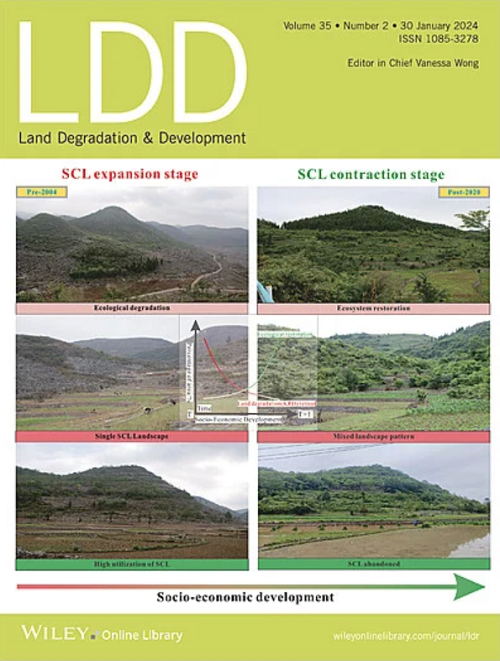Does the Reclamation Period Affect the Variation of Soil Nutrients Across Different Vegetation Types in a Reclaimed Opencast Coal Mine Dump? Validated Through Three Soil Sampling Replicates
IF 3.6
2区 农林科学
Q2 ENVIRONMENTAL SCIENCES
引用次数: 0
Abstract
Soil reconstruction and vegetation rehabilitation play essential roles in the ecological restoration of opencast coal mining areas. The significant interaction between these two initiatives has been widely recognized, but further investigation is needed to determine whether the variations in reconstructed soil nutrients among different vegetation types are influenced by the reclamation period. By conducting three repeated soil samplings in 2013, 2017, and 2021, soil nutrient data such as available phosphorus (SAP), available potassium (SAK), total nitrogen (STN), and organic matter (SOM) under different vegetation types (cereal crops [CC], herbaceous plants [HP], arbor-shrubs [AS], and wild grasses [WG]) on the surface of a reclaimed dump in the Pingshuo opencast coal mine on the Loess Plateau were obtained. Through descriptive statistical analysis, geostatistical analysis, two-way analysis of variance, and geo-detector model, this study analyzed the spatial and temporal variations in the response of reconstructed soil nutrients to different vegetation types based on different land reclamation periods. This study found that apart from SAP, spatial differences in soil nutrients were only significantly influenced by vegetation types in 2021 (p ≤ 0.05), indicating that in the early stages of reclamation (in 2013 and 2017), rehabilitated vegetation types were not sufficient to serve as the primary explanation for spatial variations in soil nutrients. However, as the reclamation period progressed, the spatial differentiation characteristics of reconstructed soil nutrients gradually became influenced by vegetation types. During the period of 2013–2017, WG represented the vegetation type exhibiting the fastest efficiency in soil nutrient restoration among SAK and STN categories. However, over the 2013–2021 timeframe, it transitioned to become the vegetation type with the slowest rate of soil nutrient recovery among SAP and SAK types. Regardless of whether in the period of 2017–2021 or 2013–2021, HP was consistently identified as the vegetation type with the quickest rate of soil nutrient restoration for the majority of nutrient categories. This highlighted the significant advantage of delineating suitable vegetation types at appropriate reclamation stages in promoting efficient soil nutrient recovery.复垦期是否会影响复垦露天煤矿堆场不同植被类型土壤养分的变化?通过三个土壤取样副本验证
土壤重建和植被恢复在露天采煤区的生态恢复中发挥着至关重要的作用。这两项措施之间的重要相互作用已得到广泛认可,但要确定不同植被类型之间重建土壤养分的变化是否受复垦期的影响,还需要进一步调查。通过2013年、2017年和2021年三次重复土壤采样,获得了黄土高原平朔露天煤矿复垦堆场地表不同植被类型(谷类作物[CC]、草本植物[HP]、乔灌木[AS]和野草[WG])下的土壤养分数据,如可利用磷(SAP)、可利用钾(SAK)、全氮(STN)和有机质(SOM)。本研究通过描述性统计分析、地理统计分析、双因子方差分析和地理探测模型,分析了不同土地复垦时期重建土壤养分对不同植被类型响应的时空变化。本研究发现,除SAP外,土壤养分的空间差异仅在2021年受植被类型的显著影响(P≤0.05),表明在复垦初期(2013年和2017年),恢复植被类型不足以作为土壤养分空间差异的主要解释因素。但随着填海期的推进,重建土壤养分的空间分异特征逐渐受到植被类型的影响。在 2013-2017 年期间,以 WG 为代表的植被类型在 SAK 和 STN 两类植被类型中表现出最快的土壤养分恢复效率。然而,在 2013-2021 年期间,它转变为 SAP 和 SAK 类型中土壤养分恢复速度最慢的植被类型。无论在 2017-2021 年期间还是 2013-2021 年期间,在大多数养分类别中,HP 始终被认定为土壤养分恢复速度最快的植被类型。这凸显了在适当的开垦阶段划定合适的植被类型在促进土壤养分高效恢复方面的显著优势。
本文章由计算机程序翻译,如有差异,请以英文原文为准。
求助全文
约1分钟内获得全文
求助全文
来源期刊

Land Degradation & Development
农林科学-环境科学
CiteScore
7.70
自引率
8.50%
发文量
379
审稿时长
5.5 months
期刊介绍:
Land Degradation & Development is an international journal which seeks to promote rational study of the recognition, monitoring, control and rehabilitation of degradation in terrestrial environments. The journal focuses on:
- what land degradation is;
- what causes land degradation;
- the impacts of land degradation
- the scale of land degradation;
- the history, current status or future trends of land degradation;
- avoidance, mitigation and control of land degradation;
- remedial actions to rehabilitate or restore degraded land;
- sustainable land management.
 求助内容:
求助内容: 应助结果提醒方式:
应助结果提醒方式:


